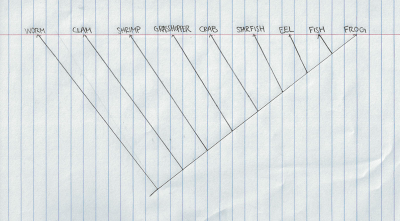My Cladogram
Reasoning
Frog:
Frog Characteristics according to dissection:
-It has a skeleton with a spinal cord as provided in the second picture
-It has paired appendages (paired eyes, legs, organs)
-It has a visible digestive tract
-The reason why I think it is the most complex is because it has legs in addition to it's existing traits
Fish:
Fish Characteristics according to dissection:
-It has a skeleton with a spinal cord
-It has paired appendages (fins, eyes)
-It has a visible digestive tract
-However I do not believe it is not more complex than a frog because it does not have legs
-Despite this, I believe the fish is more complex than the eel because it has more fins
Eel:
Eel Characteristics according to dissection:
-It has a skeleton with a spinal cord
-It has paired appendages (fins, eyes)
-It has a visible digestive tract
-However I feel it is less complex because it has less fins than a fish (it only has dorsal, anal, and caudal fins)
-It is more complex than a starfish because it has a spinal cord
Starfish:
Starfish Characteristics according to dissection:
-It has a skeleton, but with no spinal cord
-This is due to the fact that is has no paired appendages
-The reason the starfish is more complex is because it has a visible digestive tract (seen in the centre which is it's stomach)
Crab:
Crab Characteristics according to dissection:
-It has an exoskeleton
-Crabs have paired appendages (legs, eyes, claws)
-A digestive tract is also visible after cracking it open
-I believe it is more complex than a grasshopper because it has more internal organs (such as gills, visible heart, more muscles and tissues)
Grasshopper:
Grasshopper Characteristics according to dissection:
-The grasshopper has an exoskeleton
-It also has paired appendages (legs, eyes, wings)
-I am assuming that the organ sticking out (near the bottom-left of the picture) is part of the grasshopper's digestive tract (the stomach)
Shrimp Characteristics according to dissection:
-It has an exoskeleton
-It has paired appendages (eyes, legs, swimmerets, antennae)
-However according to the pictures, there is no visible digestive tract (even though my experiences of eating shrimps has led me to discover a digestive tract)
-If there was a visible digestive tract, which there should be, I would place the shrimp right before the crab on the cladogram because crabs have specialized appendages (for swimming) and because the grasshopper has less internal organs. Crabs and Shrimps are also both aquatic organisms, which is also why I think they are more closely related
Clam:
Clam Characteristics according to dissection:
-It has no skeleton but is protected by a shell
-It also has no appendages
-There is, however, a visible digestive tract
-The reason why I believe a clam is more complex than a worm is because of the shell to protect it
Worm:
Worm Characteristics according to dissection:
-It has no skeleton
-Nor does it have any visible appendages
-It has a digestive tract
-However, I believe it is the least complex because it seems to have the least amount of protection in the case that is has no skeleton or shell to protect itself














No comments:
Post a Comment